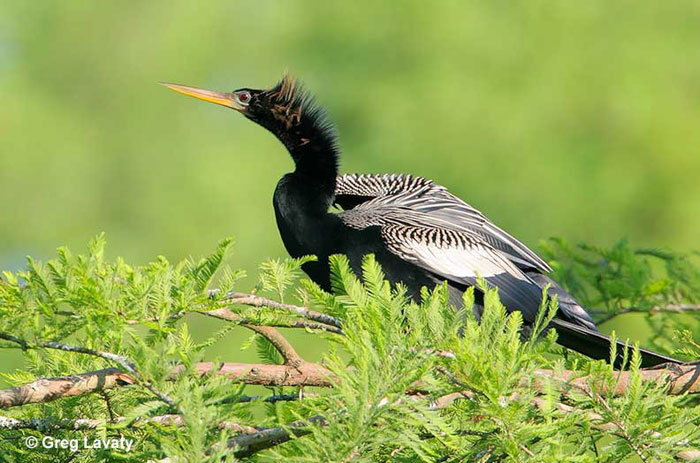Anhinga (Anhinga anhinga), the sleek and fascinating waterbird, has earned the nickname “water turkey” for its distinct fan-like tails that resemble those of turkeys.
Often seen basking in the sun with their wings spread wide, these creatures are both remarkable and mysterious, boasting unique characteristics that set them apart from other aquatic birds.
From their dagger-like bills to their ability to dive effortlessly underwater, the Anhinga is a fascinating creature worth looking into.
On this page
Identification
Anhingas can be recognized by their large size, long necks, and turkey-like tail. They measure between 29.5-37.4 inches long, weigh between 46.7-47.6 ounces, and have an average wingspan of 42.9 inches.
Their long yellow bill is dagger-like, and their legs are webbed and yellow. During flight, they hold their wings flat and neck and tail straight, which makes the bird look like a flattened cross.

Male Anhingas have a black plumage that has a glossy green and/or blue sheen in the right light. It has stunning silver-white streaks on its wings and back. The tip of its tail is also white. The feathers on the back of their head and neck are elongated and lighter in color. Males also have a black crest.
Female Anhingas are similar to males in shape and size, but the color of their plumage is a bit different. Their head, neck, and upper chest are either pale grayish buff or light brown. Their backs are duller and appear browner than the male’s back.
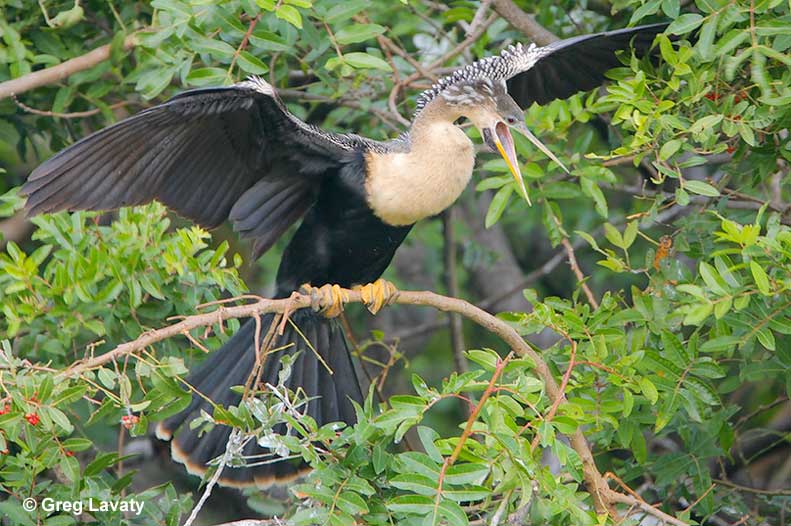
Female Anhinga
As with most birds, Anhinga’s offspring are featherless when they first hatch. They develop a light brown down after a few days and within two weeks it is replaced by white down. After about three weeks, juvenile Anhingas are mostly brown.
Anhingas sound like frogs. They use croaks, rattles, clicks, and grunts to communicate. However, these birds are usually quiet and only call when they’re near the nest or while flying.
Food
Anhingas are carnivores, mainly piscivores. They mostly feed on small to medium-sized fish that have little to no value to humans, such as mullet, sunfish, catfish, pickerel, gizzard, shad, and sucker.
Their diet also includes other small creatures found near or in water, including amphibians, such as tadpoles, reptilians, such as snakes, small turtles, and baby alligators, crustaceans, such as shrimp, crayfish, and crabs, and aquatic invertebrates and insects.
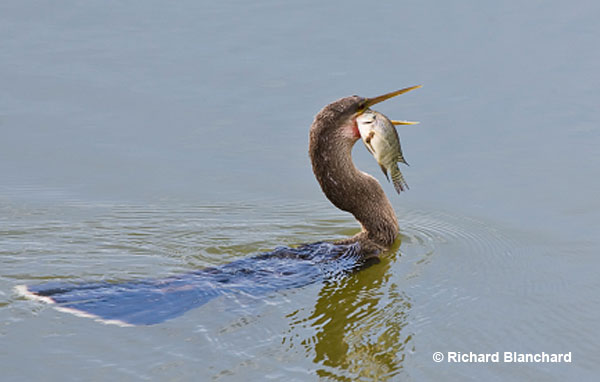
Their hunting habits are rather different from most birds. They hunt for fish near aquatic plants while slowly swimming underwater, stalking their prey and looking for slower-moving targets since they’re not fast swimmers.
Once they locate their prey and get close enough, they partially open their bill and quickly thrust it forward, impaling the prey with their bill.
They impale bigger targets with both mandibles but only use one for smaller fish. If the prey is very large, the bird stabs it repeatedly, lets it go, brings it to the surface, tosses it into the air, and catches and consumes it.
Nesting and Eggs
Anhingas are monogamous birds that may nest in isolated pairs, in mixed colonies with herons, cormorants, and ibises, but usually in groups. The male chooses the nesting site and starts to gather material even before finding a mate.
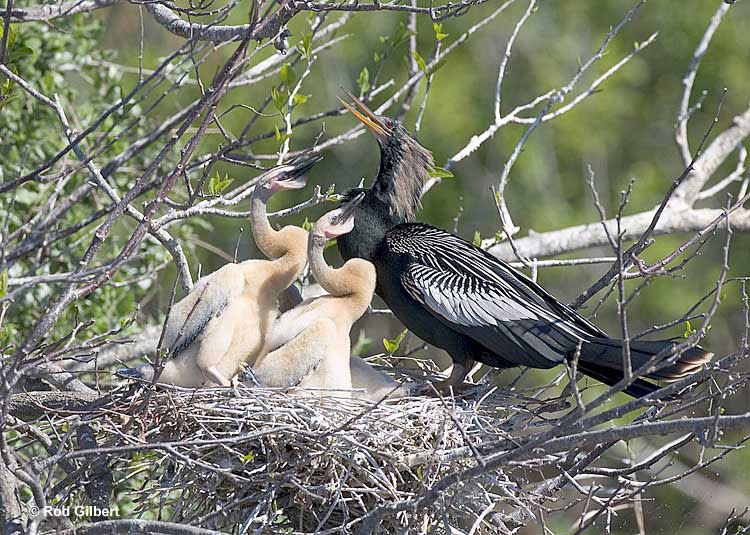
Anhingas nest near the water in a tree. The male gathers most of the material, whereas the female is the primary builder. A completed nest is a platform made of sticks that has live twigs and green leaves woven into it. They may also overtake a heron’s or an egret’s nest. As time passes, the accumulation of excrement on the outer edge of the nest can give it a white look.
These birds have one brood per year and have 2-5, on average 4 whitish to pale blue eggs with a chalky coating in a clutch. Anhinga eggs are 1.9-2.3 inches long and 1.3-1.5 inches wide. Both parents take part in the 25–30-day incubation process and both of them also take care of the young.
Once hatched, the offspring stay in the nest for 14-21 days. The parents drip fluid and regurgitate partly digested fish to feed the chicks and as the chicks age, they start to shove their heads into the parents’ mouths.
If the chicks are threatened, they may drop down from the nest and swim away. If possible, they climb back into the nest when the threat has passed. After leaving the nest, the parents take care of them for a few more weeks before they become independent.
Current Situation
Anhingas range in the warmer parts of the Americas and the species has been divided into two subspecies based on their location.
A. a. anhinga inhabits South America and can be found east of the Andes from Colombia and Ecuador down to Uruguay and northeastern Argentina.
A. a. leucogaster is found in the southern United States, Cuba, and Central America. Their range is determined and limited by the amount of sunshine and temperature.
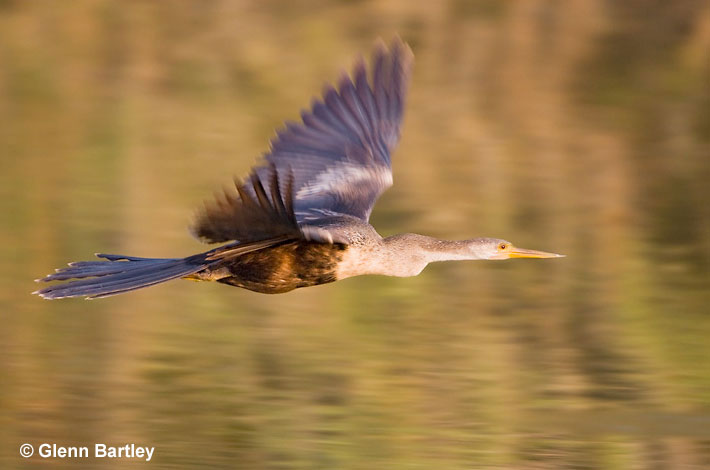
These birds are mostly found near shallow and quiet waters that have trees next to them and an area for drying their feathers in the sun. Anhinga’s habitats include freshwater and coastal aquatic habitats, such as lakes, swamps, mangrove and cypress swamps, marshes, lagoons, and shallow coastal bays.
Anhingas are mostly year-round residents but migrate based on temperature and the amount of sunlight. Birds in the extreme ends of the areas migrate towards the equator for the winter.
Anhingas are numerous in the Americas and are listed as species of least concern in the IUCN Red List. However, it is difficult to estimate the size of their population because they are an uncommon sight, and their habitats are difficult to reach.
Threats to the Anhinga population include loss of habitat and discarded fishing lines.
Facts
- Anhinga’s feathers get completely wet when they get into the water, making it easier for them to dive and move underwater which is beneficial when hunting. However, the downside of this is that they lose heat more quickly, it hinders flight, and they have little buoyancy.
- When Anhingas are wet, they’re unable to fly properly. That’s why you may see them “running” short distances on the water, rapidly flapping their wings to get away from anything they perceive as a threat.
- Anhingas are birds of many names. Their body shape and turkey-like tail earned them the nickname “water turkey”. “Snakebird” was given to them as a result of how their long neck resembled a snake when they swim in the water. They’re also known as devil birds, darters, and American darters.
Similar Species
Anhingas have quite a unique look, which is why you won’t meet many other similar species. However, the two we’ve listed here might have you do a double-take.
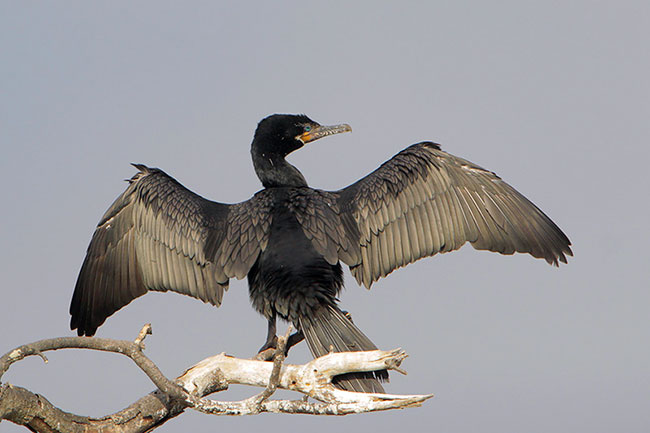
Neotropic Cormorant
If you look closely, Neotropic Cormorants are a bit smaller than Anhingas and also have a shorter tail, bill, and neck.
They’re black overall and don’t have the whitish wing patches the Anhinga does.
You can also differentiate between the two based on their behavior – Anhingas are almost completely submerged while swimming, whereas the cormorants aren’t.
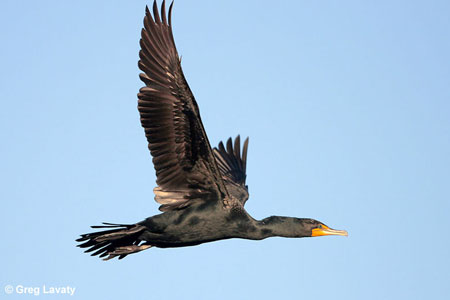
Double-crested Cormorant
Although about the same size, Double-crested Cormorants have a shorter neck and tail. They have a dark plumage overall, lacking the white wing patches the Anhinga has.
However, they have a white stripe similar to an eyebrow on their head that Anhinga doesn’t have.
In flight, Anhingas appear slenderer.
Frequently Asked Questions
Why is the Anhinga called a devil bird?
Anhinga’s name comes from a native South American (specifically from Brazilian Tupi) language where the name means “devil bird” or a “snake bird”. It got its name due to its long, snake-like neck which is the only visible part of it when the bird is swimming.
What is the difference between Anhinga and Cormorant?
The main difference between Anhingas and cormorants is the shape of their bill and how they swim. Cormorants’ bill curves downward, whereas Anhingas’ bill is sharp and pointed. Anhingas submerge almost wholly while swimming with only their head pointing out, whereas cormorants don’t.
Is an Anhinga in the duck family?
Anhinga isn’t in the duck family. It belongs to the darter family, which is called Anhingidae.
What does an Anhinga represent?
Anhingas represent different things based on location and culture. Southern tribes see Anhingas as a bad omen for their snake-like neck, whereas the northern tribes believed that the bird represents guidance and healing. Overall, they are seen as the symbols of both the gods and the devil, strength and cooperation but also greed and weakness.

